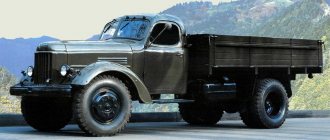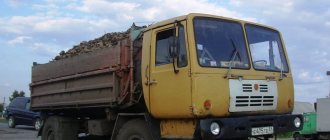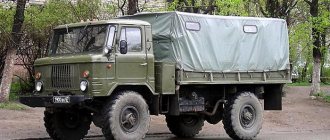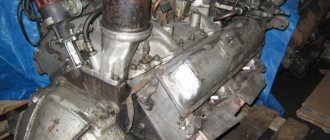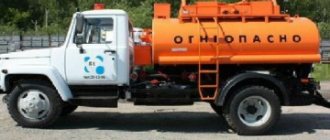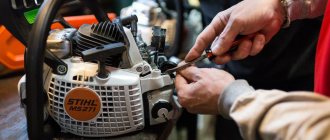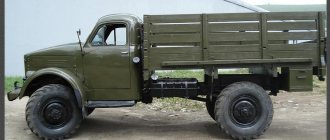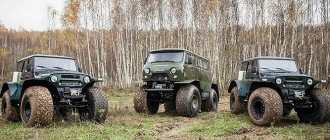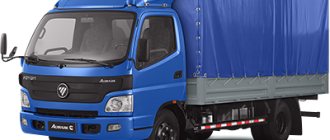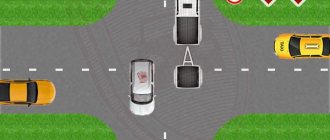P. Aleshin
The cross-country ability of this truck, which has been in production for over 30 years, can still be called outstanding. The path to its creation was long and difficult, but everyone who worked behind the wheel of these all-terrain vehicles remembers them with kind words. Numerous versions of the ZIL-157 model could be found in the Far North, and on construction sites in Siberia, and on pipeline laying in Central Asia, and, of course, in the armies of many countries around the world. Undoubtedly, this was one of the worthy domestic developments, and it deserves to be remembered.
At the end of the 1930s, when the inevitability of World War II was beyond doubt, designers of European factories producing army vehicles were racking their brains over how to increase the cross-country ability of vehicles. Their efforts did not go unnoticed in the USSR, because serious attention was paid to issues of increasing defense capability. The greatest successes in this matter were achieved at the Gorky Automobile Plant, where constant velocity joints were first introduced into production, turning the front axle of a car into a drive axle. The merit of the design team under the leadership of Andrei Aleksandrovich Lipgart lies in the fact that, having tested various two-axle and three-axle trucks, they proved that all-wheel drive vehicles should have single-pitch tires, tires with a special tread for various driving conditions on the terrain, special weight distribution along the axles, etc. It’s a pity that the war prevented the implementation of plans to produce a family of all-terrain vehicles, and after the war the country received only one two-axle all-wheel drive truck, the GAZ-63, although it had unique cross-country ability.
At the Moscow Automobile Plant named after. Before the war, Stalin managed to produce a small batch of ZIS-32 two-axle off-road trucks. At the end of the 1940s, designers sought to create the Soviet Studebaker US 6x6, taking as a basis its technical features and based on the units of the new 4-ton ZIS-150 truck. As you know, these legendary all-terrain vehicles with gable rear wheels proved themselves to be excellent in battles with the Nazis, including as carriers of the famous Katyusha launchers.
The three-axle ZIS-151, to the great chagrin of its creators, turned out to be much worse than the Studebaker. Put into production in April 1948, a year later, during a long run on the spring off-road, it was significantly inferior in cross-country ability to both the Lend Lease prototype and the GAZ-63 all-terrain vehicles, which more than once had to pull ZIS vehicles out of mud and snow captivity. Heavy vehicles (the weight of the ZIS-151 exceeded the weight of the Studebaker by a ton) with small wheels and insufficient ground clearance, low-power engines and rear axles with double tires were nicknamed “irons” among testers, forcing drivers to remove the second ramps and push the stuck one. car with another car, fortunately the design of the special rear bumpers allowed this. In the memoirs of the testers, one can read that thick liquid mud easily covered the rear wheels, turning them into four barrels, spinning helplessly in the mud mass. Removing the outer slopes covered with mud, picking out the dirt with a crowbar, was a real pain, but this was necessary to increase cross-country ability. Gable wheels required more power from the engine, as they laid additional tracks, while on the GAZ-63 the rear wheels walked exactly along the track of the front ones.
Truck with Soviet know-how
The errors had to be corrected as soon as possible, especially since the ZIS-151 trucks were entering the army, and the ways to solve the problems did not look vague. In 1950, production of the BTR-152 armored personnel carrier began based on modified ZIS-151 units, but with single-pitch tires on all wheels with larger tires. The plant created experimental samples of ZIS-151 trucks with single-pitch wheels and a single track bridge, and began work to increase engine power, increase the reliability of other units, and design winches. But the main hopes associated with a radical increase in cross-country ability were placed on the system of centralized regulation of air pressure in tires being created (for the first time in world practice). Tire manufacturers were tasked with developing a design and mastering the production of special tires that allow the vehicle to move with a temporarily reduced air pressure in them. As a result, a tire of size 12.0018 was developed (air pressure range 3.0...0.5 kgf/cm2), allowing the ability to work with a variable radial deformation of up to 35% of the profile height, while for conventional tires the radial deformation is no more than 13%. The tire was distinguished by increased elasticity, achieved by increasing the profile width by 25%, reducing to eight layers of cord in the carcass and using special layers of very soft rubber.
As the air pressure in the tires decreases, deformation increases and the specific ground pressure decreases. As a result, the rut depth is reduced and, accordingly, energy costs for rut formation are reduced or the soil resistance to wheel rolling is reduced. True, it was possible to move at an air pressure of 0.5 kgf/cm2 only at a speed of no more than 10 km/h.
The change in tire pressure was carried out by the driver using a centralized system, which made it possible to regulate and, if necessary, bring the pressure in all tires to normal while the car was moving. The military especially liked the use of such a system. The fact is that with this system the survivability of the car was higher. The truck could continue to move even if an individual tire was damaged, since the inflation system compensated for the drop in air pressure in it.
Tests of the new system fully confirmed the theoretical research, and when developing the new ZIL-157 vehicle, which replaced the ZIS-151 all-terrain vehicle on the assembly line in 1958, the choice was made in favor of a new tire size 12.0018. As a result, the designers had to radically reconsider the layout of the all-terrain vehicle. Reducing the number of wheels from 10 to 6 made it possible to avoid the installation of two spare ones, which were mounted on the ZIS-151 vertically behind the cabin. This decision led to the elimination of the wheel holders behind the cab and made it possible to move the platform closer to the cab, and to shorten the frame at the rear by 250 mm, which reduced the overall length of the truck by 330 mm with the same wheelbase. The only spare wheel found a place under the platform.
Optimization of the layout of the ZIL-157 truck improved the weight distribution along the axles, while the weight of the vehicle decreased by 100 kg.
At first, cars used a system for regulating air pressure in tires with external air supply through tubes with articulated joints, but very soon serious shortcomings of this design became apparent. While the all-terrain vehicle was driving off-road, the protruding outer tubes were damaged, the hub seal in the air supply unit turned out to be poorly protected from dirt, and mounting and dismantling the wheels caused great difficulties. As a result, almost immediately after the start of production of the car, the air supply unit to the tire was redesigned in favor of supplying air from the inside of the wheel.
Why was the Soviet ZIL-157 truck called the “Cannibal”?
The Soviet military truck ZIL-157 is still called by many motorists to this day the best off-road truck of the USSR, and indeed of modern Russia too.
The only interesting point is the fact that all the odes to this model, which make it legendary, were created by the owners who worked on it for a long time and valued it for its reliability and simplicity of design.
Manufacturability. The ZIL-157 was an incredibly technologically advanced truck that stood out among similar models due to its good technical data, high reliability and controllability. Undoubtedly, the outstanding high-tech feature is the standard tire inflation system, which was used only on this truck model and was not repeated.
Serial release. Manufacturers have been working on creating this truck for a long time. They understood perfectly well that the most important thing was to create a high-quality model that fully meets the basic requirements of Soviet drivers. Many different versions of the truck were built, but only this modification was able to go into production.
When creating the model, manufacturers partially copied the previously presented ZiS-151 truck, but at the same time modified the main components and made the vehicles more modern by those standards.
Name . There was not a single truck in the USSR that had so many different names and nicknames. This model was called differently. The most interesting options were: Iron, Studer, Zakhar, Zakhar Zakharovich, Cleaver, Stupa, Crocodile, Iron, Murmon and of course Ogre. Moreover, the latter was very extravagant and unexpected, but it happened.
The truck got this nickname because it broke the hands, fingers or even forearms of many young drivers. That is why experienced drivers have always said that when getting behind the wheel of a “Cannibal”, you need to be extremely attentive and responsible. Otherwise, troubles cannot be avoided.
The most important thing while holding the steering wheel was not to put your fingers under the spokes, but many young drivers did this, even despite all the warnings. They were confident that they were in control of the process. However, the steering wheel turned out to be very heavy and it was no longer possible to cope with it.
Note that in the USSR the old KRAZ vehicles were also called the Cannibal, but they were much more dangerous than the ZIL-157. However, the name itself spoke for itself, hinting to drivers that they need to be more attentive and responsible in order to avoid serious problems and troubles, including health problems.
Bottom line. One of the best Soviet trucks had a lot of advantages, so it was used in car depots for a long time. But a large number of inexperienced drivers suffered from the operation of this car, who received serious injuries and injuries. That is why the truck received the nickname Cannibal, which firmly stuck to it throughout the entire period of operation.
Powertrain modernization
Experience in operating ZIS-151 vehicles revealed their low traction-dynamic qualities, especially when towing a trailer, the engines often overheated, the truck consumed a lot of fuel, had low average speeds on paved roads, and the reliability of the components did not suit the operators at all. All this had to be corrected when creating the ZIL-157. The use of an aluminum cylinder head on an in-line lower-valve 6-cylinder engine with a displacement of 5.55 liters made it possible to increase the compression ratio from 6.0 to 6.2, which, together with the installation of a new carburetor, increased power from 92 to 104 hp. at 2600 rpm and maximum torque from 304 to 334 Nm. The cooling system has also undergone significant changes, which received a six-blade fan and a new radiator. A new oil pump, new crankshaft seals, water pump seals, a closed crankcase ventilation system were introduced into the engine design, the suspension of the power unit, etc. was modernized, which increased its performance properties. Constructive measures led to a reduction in fuel consumption of the ZIL-157 vehicle by 7...22%, depending on road conditions.
During the production process, the car's engine was upgraded twice more. In 1961, its power was increased to 109 hp. (model ZIL-157K), replaced the double-disc clutch with a single-disc one, and from 1978 the truck began to be produced with an engine in which a number of components were unified with the engine of the ZIL-130 car (this version was called ZIL-157KD). The gearbox with 5 forward gears and one reverse gear was also strengthened, and until 1961 it was produced with a fifth overdrive gear, which was later abandoned. The two-stage transfer case with forced engagement of the front axle, compared to the ZIS-151, was produced with wear-resistant gears and new seals, and the cardan drive was designed anew. The transmission of torque to the rear axle was carried out using a promotional pore mounted on the middle axle. The drive axles received significantly reinforced axle housings, new hubs and brakes. The number of wheel studs has increased from 6 to 8.
It became more convenient for the driver
Among the comments regarding the ZIS-151 model were complaints about the cabin: the inconvenience of the driver sitting on a non-adjustable seat, the lack of a heater, its poor dust protection, unsatisfactory air ventilation, as well as the ineffective operation of shock absorbers and large forces transmitted to the driver’s hands from the wheels. All of the above made the driver’s work difficult, turning it, especially in winter, into downright agony. It turned out that eliminating the shortcomings was not so difficult. In the steering control, the designers installed a shortened bipod, which led to a significant reduction in the impact forces transmitted to the hands, telescopic shock absorbers increased the smoothness of the ride, a water radiator with an electric motor installed in the cabin, complemented by a windshield blowing system, made it possible not to freeze in winter, new seats with adjustable and the introduction of high-quality seals in the cabin made life easier for the driver. It’s just a pity that during the 30 years the car was produced, it was not possible to equip it with power steering.
Long-lived prize-winner
The carrying capacity of the all-terrain vehicle on paved roads was limited to 4.5 tons (since 1978 - 5.0 tons), on dirt roads - 2.5 tons. The truck overcame a ford with a depth of 0.85 m, and reached speeds of up to 65 km/h, consumed 42 liters of fuel per 100 km. At normal tire pressure (3.0...3.5 kgf/cm2), the ZIL-157 performed transport work on roads with hard, unimproved surfaces. When the pressure decreased to 1.5...2.0 kgf/cm2, it easily moved on soft and loose soil, and at 0.75...1.0 kgf/cm2 it overcame sand, wet soil and dirt roads washed out after a rainstorm. Tire pressure 0.5...0.7 kgf/cm2 made it possible to move freely through damp meadows, wetlands, and also successfully overcome deep snow cover. The total weight of the towed trailer when driving on the highway was 3.6 tons.
For its high performance parameters, the car received the Grand Prix at the 1958 World Exhibition in Brussels. It was exported to dozens of countries around the world. Serial production of models of the ZIL-157 family, which included a good dozen of various designs, continued at the Moscow Automobile Plant named after. Likhachev until 1988, i.e. for many years after the release of more modern ZIL-131 vehicles. In 1978–1994 the car was assembled at the Ural Automotive Plant (Novouralsk), at that time a branch of ZIL. A total of 797,934 ZIL-157 vehicles of all modifications, which many call the “kings of off-road”, were produced.
Zakhar Zakharych, Crocodile, Cleaver and Brussels winner: military modifications of the ZIL-157
The all-wheel drive 2.5-ton three-axle vehicle ZIL-157 with popular nicknames “Zakhar Zakharych”, “Crocodile” and “Cleaver” was created as a slightly modernized version of its predecessor, which managed to implement the most progressive solutions that did not find support from the military customer in the mid-40s . First of all, these were all single wheels with the same track, as well as a system for regulating the internal air pressure in the tires, borrowed from the ZIS-485 amphibian.
An army truck ZIL-157KD with a single-axle technological trailer is being tested. 1977
Serial production of the ZIL-157 began in September 1958, and it soon won the main prize at the World Exhibition in Brussels, where it was presented as a truck for agriculture. Over time, it turned into the highest achievement of the domestic automobile industry, a long-liver of the Soviet automobile industry, produced in three generations, and into the main vehicle of the Soviet army and many foreign countries.
Three generations of ZIL-157
The first generation of 1958-1961 laid down an almost unchanged concept and parameters of the entire ZIL-157
with an engine power increased to 104 horsepower, a three-seat all-metal cabin with folding windshields, the same on-board platform and new hood and radiator linings. The presence of a winch was not mentioned in the markings.
Military truck ZIL-157 of the first generation with an awning and a winch. 1958
On second generation ZIL-157K
(1961-1978) units of ZIL-130 and ZIL-131 trucks were used, which were assembled on neighboring conveyors. They were equipped with a new single-disc clutch, a synchronized gearbox and a simplified tire pressure regulation system.
Second generation ZIL-157K car with front hydraulic shock absorbers. 1961
Production of three-ton vehicles of the third generation ZIL-157KD
(1977-1992) was deployed at the Ural Automotive Plant (UAMZ).
Its products were distinguished by the installation of a 110-horsepower engine, a reinforced chassis, new lighting devices and a body from the ZIL-131. ZIL-157KD third generation from the collection of the ZIL plant (photo by the author, 2011)
These cars acquired an extensive train of small-scale variants, among which were single-wheel tractors, chassis for mounting various bodies and superstructures with power take-offs for their drive, as well as export versions for use in countries with different climatic conditions.
The basic versions of trucks with shielded electrical equipment of three generations bore the indices ZIL-157EG, 157KG and 157KDG, respectively.
Export truck ZIL-157KE with a 4.5-ton winch in the Finnish armed forces
Military equipment on the ZIL-157 chassis
Serial flatbed trucks carried 16-18 personnel and military cargo in their bodies, and also served as tractors for trailed artillery and missile systems. Their cabins were equipped with mounts for the crew’s personal weapons, a decontamination kit, a first aid kit and a fire extinguisher, and on a number of vehicles a light “trunk” was mounted on the roof.
ZIL-157KD with transverse benches in the back for personnel at the parade in Moscow on May 9, 1985
A ZIL-157K truck with soldiers of the Soviet army at the monument to the Soviet tank in Prague. 1968
From the ZIS-151, the new cars inherited many of the previous professions, and also for the first time received up to 100 options for special superstructures, including the first Soviet means for transporting, loading and ensuring the combat effectiveness of ballistic missiles. We have already talked about the famous Katyushas on ZILs.
Standard box bodies
At the end of the 50s, the Soviet military industry mastered the serial production of a whole range of habitable van bodies of various designs, which made up a unified standard range. On ZIL-157 trucks, wood-metal bodies KUNG-1M were first installed, which were later replaced with lightweight frameless structures K-66 and frame-metal KM-66, created for installation on GAZ-66 cars. For special purposes, K-44 sliding vans and K-35 bus-type staff vans were used.
Serial van body KUNG-1M on the ZIL-157 chassis. 1961 (archive of 21st Scientific Research Center)
Frameless body KM-66U1D with reinforced foam panels. 1964 (archive of 21st Scientific Research Center)
ZIL-157K with sliding walls of the K-44 body for placing headquarters and canteens. 1964 (archive of 21st Scientific Research Center)
Radio communication and control equipment
Numerous types of military radio stations, radar points, headquarters control equipment, direction finders and even tropospheric (space) communication systems were placed in KUNG or K-66 vans, which were based on the ZIL-157 chassis of the second and third generations with shielded electrical equipment.
Radio station R-140 "Stripe" in the back of K-66U1D on the ZIL-157KEG chassis in the Hungarian army
Station P-15M “Trail” in the back of KUNG-1M. 1959
Airfield radar station RSP-7
Vehicle maintenance and repair equipment
The narrow specialization of automobile repair facilities for carrying out maintenance and repair of various types of military equipment in the field led to the creation in the 50s of two main complexes of mobile automobile repair shops (PARM) and military automobile repair and maintenance workshops (VAREM), which used ZIL chassis -157 with SN, KUNG-1M and KM-66 bodies with repair equipment.
Auto repair shop VAREM-3D in a SN body with wheel arches
Field workshop MTO-60 for maintenance of vehicles and weapons in the Finnish army
Fuel service vehicles
Military vehicles of this category on the ZIL-157/157K chassis were a development of vehicles based on the ZIS-151. On the new mechanized tanker ACM-4-157
its own pump appeared, allowing it to perform the functions of a fuel tanker.
The ATZ-3-157 vehicle was equipped with a tank extended by 200 liters, which made it possible to simultaneously serve four consumers, but the design of the new VMZ-157
remained virtually unchanged.
Modernized refueling tanker ACM-4-157. 1958
Tanker ATZ-3-157 with a tank for 3,500 liters of fuel. 1959
Missile systems support equipment
With the start of production of shielded trucks ZIL-157KG and 157KDE, many types of means of supporting mobile missile systems and ground-based pre-launch preparation of short- and medium-range ballistic weapons began to be installed on them. Due to the special secrecy, no one knew anything about them then, and photographs from those years have not survived.
These included refueling missile systems with oxidizer and compressor stations for refueling with compressed air or oxygen, special KUNG bodies for assembling missile warheads, storage vehicles with blank bodies and containers for transporting missile warheads, pre-launch preparation vehicles for checking cable equipment, and transporting spare parts , accessories, etc.
Refueler of 8G17M1 oxidizer on a ZIL-157EG vehicle in the Polish army. 1962
Mobile compressor station UKS-400V on the ZIL-157KDE chassis. 1986
Vehicle 2U657 with a camouflaged KUNG-1M van, in which missile warheads were assembled. 1959
Vehicles of the chemical defense troops
With the advent of the ZIL-157 car, the most common car was produced - 8T311
for washing and neutralizing missile systems, various equipment, weapons and the surrounding area with special liquids.
The ARS-12D auto-filling station was replaced by a modified model ARS-12U
. The chemical troops also served the ADM-48D degassing station and the AGV-3M degassing-air complex.
Machine 8T311 for cleaning and neutralizing military equipment. 1959
Modernized auto-filling station ARS-12U on a ZIL-157 chassis in the GDR army. 1958
Engineering vehicles
In 1958, a set of KMM
migrated from the ZIS-151A to the ZIL-157 chassis with a winch, and then to the ZIL-157K. With the help of reloading devices, the seven-meter bridge block of each of the five cars was tipped back and laid on the desired area of the terrain, covering narrow ditches and ditches.
The basic vehicle of the KMM mechanized track bridge on the ZIL-157 chassis. 1959
Modified ZIL-157K of the TPP fleet on display at the Museum of Artillery and Engineering Troops (photo by the author)
The same situation was repeated with the heavy pontoon fleet of the TPP
, who moved to a new ZIL with platforms for transporting and dropping pontoons onto the water.
The new product was the regimental mobile mast drilling rig PBU-50
with a drilling depth of up to 50 meters.
The middle pontoon of the TPP park with a set of wooden flooring in the Artillery Museum in St. Petersburg (photo by the author)
Mobile mast drilling rig PBU-50 on ZIL-157K chassis (photo by K. Dunaev)
Mobile means of transporting and loading missiles
Further development in the 50-60s of fundamentally new mobile anti-aircraft, tactical and operational-tactical missile systems led to the emergence of fundamentally new automobile reloading and transport-loading vehicles (TZM).
PR-14A was adopted
on a single chassis of a ZIL-157 vehicle, which was part of the S-125 Neva anti-aircraft complex with two solid-fuel missiles weighing about one ton each.
Transport-loading vehicle PR-14A with missiles of the Neva complex, reminiscent of an ordinary Katyusha.
1962 Meanwhile, the large dimensions and increased weight of large missiles, as well as the requirements for their safety in transit and maintaining constant combat readiness, led to the prevailing use for these purposes of road trains with ZIL-157V/KV truck tractors and special single-axle semi-trailers for transporting one missile.
For the first time, experimental ZIL-157V vehicles replaced the previous ZIS-151 tractors in 1957 and worked as part of the PR-11A TZM of the S-75 Dvina complex. Subsequently, they were produced in several versions for different versions of missile weapons. Since 1958, the modernized PR-11AM
, which delivered anti-aircraft missiles of the SA-75M Dvina complex, was the first to enter the armed forces of socialist countries. Subsequently, this system went through several more variants until it was replaced by ZIL-131V tractors.
PR-11AM vehicles with SA-75M Dvina missiles and ZIL-157KV tractors.
1967 PR-3M3 semi-trailer transport and installation vehicle entered service with the Moscow missile defense regiments
for delivery and installation at stationary launch positions of new anti-aircraft missiles of the S-25M "Berkut" complex. The mass of the loaded missile was 3.5 tons, the border of the affected area was 45 kilometers.
Installation vehicle PR-3M3 with a 12-meter missile of the S-25M "Berkut" missile defense system.
Other military road trains of the 60s with ZIL-157KV tractors included semi-trailer transport vehicles or ground carts with automobile units, which served for the delivery of wheeled and tracked weapons operationally -tactical complexes with high-explosive fragmentation or nuclear warheads. Their length was slightly more than 15 meters, the maximum permissible speed was 40 km/h.
Transport vehicle 2U663U with a heat-protective cover for the delivery of nuclear missiles of the Luna complex. 1964
Ground cart 2T3M for transporting tactical missiles with a heating system for the warheads. 1965
The title photo shows an army truck ZIL-157KD from the Ural Automotive Plant on display at the Museum of Military Vehicles in Ryazan.
